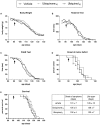A mouse model of familial ALS has increased CNS levels of endogenous ubiquinol9/10 and does not benefit from exogenous administration of ubiquinol10
- PMID: 23936040
- PMCID: PMC3720666
- DOI: 10.1371/journal.pone.0069540
A mouse model of familial ALS has increased CNS levels of endogenous ubiquinol9/10 and does not benefit from exogenous administration of ubiquinol10
Abstract
Oxidative stress and mitochondrial impairment are the main pathogenic mechanisms of Amyotrophic Lateral Sclerosis (ALS), a severe neurodegenerative disease still lacking of effective therapy. Recently, the coenzyme-Q (CoQ) complex, a key component of mitochondrial function and redox-state modulator, has raised interest for ALS treatment. However, while the oxidized form ubiquinone10 was ineffective in ALS patients and modestly effective in mouse models of ALS, no evidence was reported on the effect of the reduced form ubiquinol10, which has better bioavailability and antioxidant properties. In this study we compared the effects of ubiquinone10 and a new stabilized formulation of ubiquinol10 on the disease course of SOD1(G93A) transgenic mice, an experimental model of fALS. Chronic treatments (800 mg/kg/day orally) started from the onset of disease until death, to mimic the clinical trials that only include patients with definite ALS symptoms. Although the plasma levels of CoQ10 were significantly increased by both treatments (from <0.20 to 3.0-3.4 µg/mL), no effect was found on the disease progression and survival of SOD1(G93A) mice. The levels of CoQ10 in the brain and spinal cord of ubiquinone10- or ubiquinol10-treated mice were only slightly higher (≤10%) than the endogenous levels in vehicle-treated mice, indicating poor CNS availability after oral dosing and possibly explaining the lack of pharmacological effects. To further examine this issue, we measured the oxidized and reduced forms of CoQ9/10 in the plasma, brain and spinal cord of symptomatic SOD1(G93A) mice, in comparison with age-matched SOD1(WT). Levels of ubiquinol9/10, but not ubiquinone9/10, were significantly higher in the CNS, but not in plasma, of SOD1(G93A) mice, suggesting that CoQ redox system might participate in the mechanisms trying to counteract the pathology progression. Therefore, the very low increases of CoQ10 induced by oral treatments in CNS might be not sufficient to provide significant neuroprotection in SOD1(G93A) mice.
Conflict of interest statement
Figures





References
-
- Tang PH, Miles MV, Miles L, Quinlan J, Wong B, et al. (2004) Measurement of reduced and oxidized coenzyme Q9 and coenzyme Q10 levels in mouse tissues by HPLC with coulometric detection. Clin Chim Acta 341: 173–184. - PubMed
-
- Littarru GP, Langsjoen P (2007) Coenzyme Q10 and statins: biochemical and clinical implications. Mitochondrion 7 Suppl: S168–174 - PubMed
-
- Pravst I, Zmitek K, Zmitek J (2010) Coenzyme Q10 contents in foods and fortification strategies. Crit Rev Food Sci Nutr 50: 269–280. - PubMed
Publication types
MeSH terms
Substances
Supplementary concepts
Grants and funding
LinkOut - more resources
Full Text Sources
Other Literature Sources
Medical
Molecular Biology Databases
Miscellaneous

